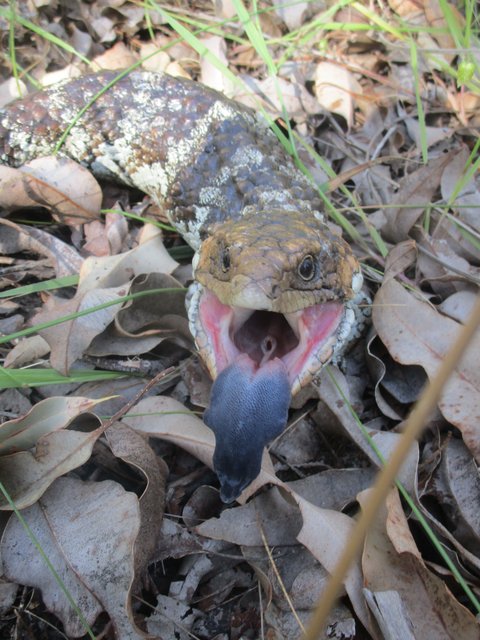
Also called a Blue Tongued Skink.
(Taken from Back Yard Buddies)
They are the largest of all the skinks. They can grow up to 60 cm long.
They are usually grey with broad brown stripes across their back and tail, and of course their most unique distinguishing feature is their blue tongue.
Blue-tongues emerge in spring from their winter homes to look for mates. They are only active during the day which makes them easy to spot.
The reason for their blue tongues is so they can flick them out when threatened and scare off predators; bright colours in nature can often mean danger or poison.
Blue-tongues will make loud hissing sounds and can rear up in anger to chase off threats. Blue-tongues have stumpy legs and cannot rely on quickly running away from predators so scare tactics are its first line of defence.
Another tactic it uses is its very powerful bite and habit of not letting go.
While not poisonous, they can give a painful bite with their impressive jaw strength. Picking them up incorrectly can also pull off their tails.
Although technically a defence mechanism to help them escape predators, this process isn’t very good for them, especially in winter, as their tail is where they store their water and nutrients and it requires a lot of energy to regrow them.
Mating for most blue-tongues begins in late winter through to December. If you see two blue-tongues looking like they’re having a vicious fight, it’s most likely mating. They can be quite aggressive towards each other and can end up with cuts and scratches but this is normal mating behaviour.
The female blue-tongue gives birth to live young three to four months after mating, which is very unusual in lizards as they normally lay eggs. Blue-tongues have between one and fifteen babies who are able to look after themselves just four days after birth.
But it will take three to four years before they are fully grown.
The blue-tongue lizard eats plant matter and mostly slow moving prey like beetles, caterpillars, crickets, snails and other small lizards.
Like snakes, blue-tongue lizards shed their skin.
During moulting season you might see them scratching themselves like a dog. It can be an uncomfortable time for them, especially the youngsters who shed their skin more often as they are constantly growing


